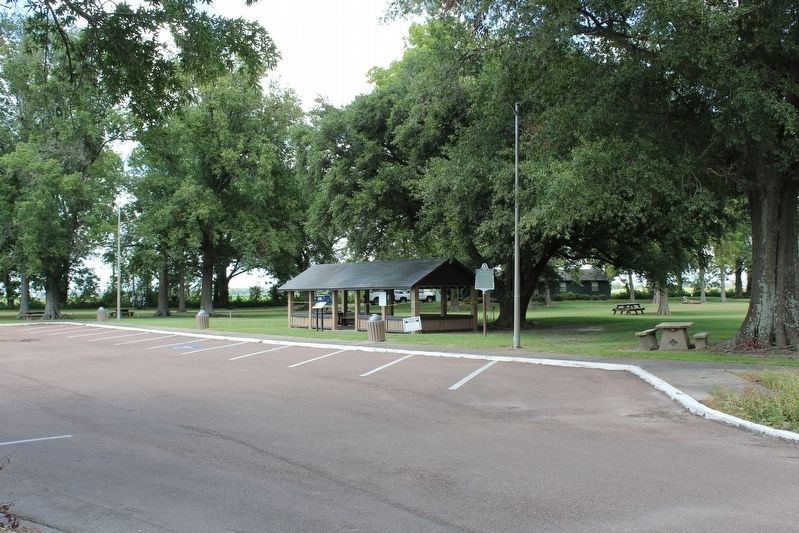Greenville in Washington County, Mississippi — The American South (East South Central)
Symbols Tell Stories
Found on artifacts, these symbols link us to ancient traditions.
Spider
The Spider is a common character in many Southeastern Tribal stories. Choctaw tradition tells how Grandmother Spider brought the Sacred Fire to humans in a clay pot.
Sacred Fire or Sun
The cross in the circle’s center represents the four logs marking the village center’s Sacred Fire in present-day Chickasaw, Choctaw, and Muscogee Creek Tribes. This Sacred Fire is linked to the Sun in many historical and archaeological accounts. Three circles surrounding the center cross symbolize the upper, middle, and underworlds. An eight-pointed sun completes the design.
Look for: Find the central cross on the Pavilion floor. Each arm of the cross points in a cardinal direction – north, south, east, and west.
Great Serpent/Underwater Panther
This shape-shifting figure represents the powers of the underworld. Sometimes depicted as a great cat with legs and fangs and other times as a fearsome serpent with a rattlesnake tail, this creature is in constant battle with the forces of the upper world.
Look for: The Issaquena Disk (photo at left) features the panther head and rattlesnake tail of the Great Serpent. The sandstone disk was unearthed in Mississippi, and a reproduction ca be seen in the Winterville Mounds Museum.
Thunder Beings
Along with Thunderbirds and other powerful sky creatures, Thunder Beings indicate approaching rain or war. A woodpecker head symbolizes the power of the sky of upper world.
Ogee
We find the Ogee on pottery and ornaments from many Mississippian cultures. Scholars believe the Ogee represents a passageway between life and death, day and night, birth and life, or the seen and unseen worlds.
Rising Sun
The meaning of the Rising Sun is not known, but it appears on pottery found at Winterville Mounds. We know that solar and lunar events were important to the mound builders, because mound sites often orient with solstices and equinoxes.
Can you find each of these symbols on the Pavilion?
The colors and symbols on the pavilion are base on the clay capping that once covered Winterville’s central and largest mound.
Topics. This historical marker is listed in these topic lists: Anthropology & Archaeology • Native Americans.
Location. 33° 29.171′ N, 91° 3.796′ W. Marker is in Greenville, Mississippi, in Washington County. Marker is on State Highway 1 north of Indian Road, on the right when traveling north. Touch for map. Marker is at or near this postal address: 1145 Indian Rd, Greenville MS 38703, United States of America. Touch for directions.
Other nearby markers. At least 8 other markers are within 5 miles of this marker, measured as the crow flies. Winterville Mounds (within shouting distance of this marker); Winterville (about 300 feet away, measured in a direct line); Lockheed T-33A (approx. 4.2 miles away); History of the 51-6601 (approx. 4.2 miles away); Harriet Blanton Theobald Park (approx. 4.8 miles away); St. Matthew's A. M. E. Church (approx. 4.9 miles away); Mt. Horeb M.B. Church (approx. 4.9 miles away); Walter Horn, Jr. (approx. 5.1 miles away). Touch for a list and map of all markers in Greenville.
Related markers. Click here for a list of markers that are related to this marker.
Also see . . . Winterville Mounds. (Submitted on August 16, 2020, by Tom Bosse of Jefferson City, Tennessee.)
Credits. This page was last revised on August 16, 2020. It was originally submitted on August 16, 2020, by Tom Bosse of Jefferson City, Tennessee. This page has been viewed 234 times since then and 97 times this year. Photos: 1, 2. submitted on August 16, 2020, by Tom Bosse of Jefferson City, Tennessee. • Bernard Fisher was the editor who published this page.

